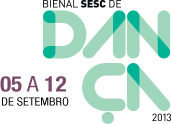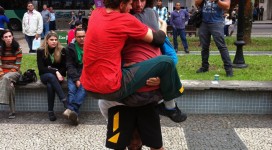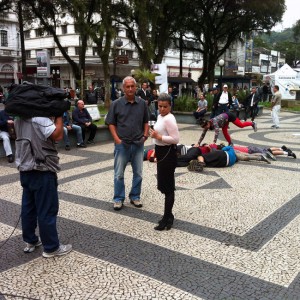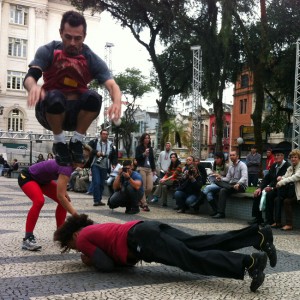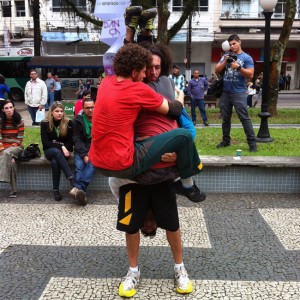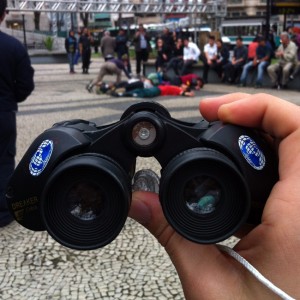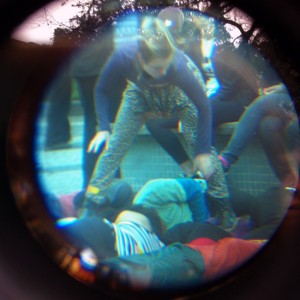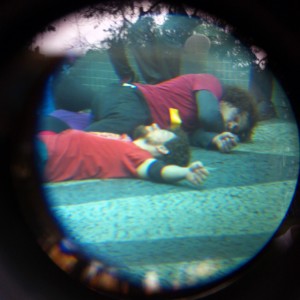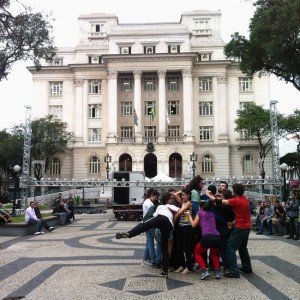blog_ 7x7
Vanilton Lakka x Bruno Freire = Keep the leftover in the pocket or purse
by BRUNO FREIRE on Mono-Blocos by Vanilton Lakka and Calaborators.
The street belongs to the unforeseen. Up to what point Vanilton Lakka and Associates’ choreography is porose to the unpredictability of the street?
“Could you please give me your cell phone number?”
The work goes through invitations to get close. Text messages will indicate what to do and when to act. A controlled choreography via mobile technology. The spectators’ mobility is framed into moving according to the rules established by messages sent from beyond (by them) to your cell phone. Good to know: yes, everybody has a cell phone. However, you may also follow the action flow and feel the game, after all, we are on the street and the game has been set up, the spectator is part of this work and the dancers gradually propose the game. They, us and the others.
“Don’t drop the ball”
Then, they enter the stage equilibrating a small ball in a spoon. Holding back. Protecting their nuts and attacking the other’s. A game that inserts the public and confuses it about who is the public and who isn’t. It’s a plural block that dismantles the logic of one Mono block or of Mono blocks. Not even the dancers are a mono mass (a oneness), the block of Vanilton Lakka’s associates are people totally distinct from each other. This distinction among different kinds of blocks is explicit when a block of Chinese tourists come in the end of the presentation and, on the other side, another block formed by other mixes, miscegenation and differences.
http://www.youtube.com/watch?v=YASdiU_hXdQ&feature=player_embedded
The title Mono-Blocos is probably due to the how the group chose the soundtrack. Mono-Loudspeaker-Backpacks amplify the music of the play, which is confused with the track of the street, creating a kind of sound environment that is the crossing of all this. Sound and action are stereo, but the work insists on thinking mono, when it’s the street that won’t let us be.
Along the work, new propositions and invitations to the public come in. However, this need to mix the public with the Mono-Blocos ends up turning these indications less and less complex. The rules of the game are simplified (even made childish). And even with basic resources to insert the other in the game, even when it’s this simple, the public sometimes jams the game. On one hand it’s rich to imagine that a choreographer is interested in choreographing the spectator, in thinking about choreographies for the spectator.
Is it a political need? Is it populist? Is it polis?
1. Just walk through the space. Attention! Don’t stop.
2. Get up and walk 5 steps in any direction.
3. Use the cell phone to take pix of the tree/robot. Get close if you want to.
Messages from ‘beyond’ – Mobile Technology – Technology of mobility in/of and through the body
The insertion of the public, the interactivity, the participation, as well as other rules that little by little become recurrent in art or in a dance work, and also the desire to unbalance hierarchy, to question power, research work, theory and practice, may become surveillance rules. Certain thoughts of the contemporary dance come out as a political strategy to become the rule. When the exception is the rule, politics become police.
“Red Blouse”
“Gray T-shirt”
“White Shirt”
So close, so far. The simple effect of altering the distances of the scene. The displacement of zooming in the show. Just this small scene move is participative because it demands the displacement of looking. The hierarchy of the eye is broken. The choreography and the ballerinos become small because they are far away. What does it matter to see? What is to see? It demands a choice from the public. To see is already a choice. What you choose to see at the Santos Biennial may be a political or a militia choice.
The Globo reporter, the Chinese blocks, the sweeper, the lawyer, the secretary, the dancer, the street walker, the camera man, the economist, the passer by, the organized Sesc team, all the social actors who crossed this space were part of the same choreography full of unpredictability. Maybe that is why a latent need to make its rules explicitly clear exists in choreography, so that it may develop its systems.
Notebook
Globo
television and dance
the street dances
in the street you dance
process in Excess
keep the leftover in the pocket or purse
the people are public
ambulant music
street
logic
structure
system
game
the street is public
the dance is on the streets
mobilize, alter points of view and displace the field of vision, zoom in
participation may limit or tie up the choreographic constructions
mono-blocks
pluri-blocks
polis-blocks
hacker
sit down on the open code
sit down on the QRCode
walk non-stop
Text and photos by Bruno Freire, who acts as an interpreter and performer since 2004, has a Master’s degree in Communication and is about to immigrate to the ex.e.r.ce master in Montpellier.
Translation Portuguese-English: Chris Ritchie, M.A.
